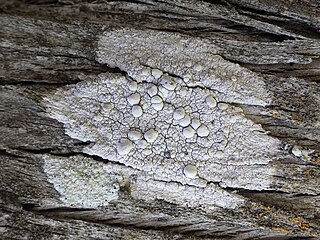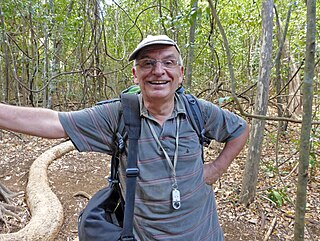
Isalo National Park is a National Park in the Ihorombe Region of Madagascar, in the southwestern corner of the Province of Fianarantsoa. The closest town is Ranohira, and the closest cities are Toliara and Ihosy. It is a sandstone landscape that has been dissected by wind and water erosion into rocky outcrops, plateaus, extensive plains and up to 200 m (660 ft) deep canyons. There are permanent rivers and streams as well as many seasonal watercourses. Elevation varies between 510 and 1,268 m.

The Roccellaceae are a family of fungi in the order Arthoniomycetes. Most taxa are lichenized with green algae, although some are lichenicolous, growing on other lichens.

Enterographa is a genus of lichens in the family Roccellaceae.

Dirina is a genus of lichen-forming fungi in the family Roccellaceae. All Dirina species are crustose lichens with a whitish to greyish brown thallus, and live either on rock or on bark–some species can live on both. The photobiont partner is a member of the green algal genus Trentepohlia. Most species occur in the Northern Hemisphere, and are generally restricted to coastal habitats, where they may be locally quite common. Erythrin and lecanoric acid are lichen products that usually occur in Dirina species, along with several other unidentified substances.

Lecanactis is a genus of crustose lichens, commonly called old wood rimmed lichen. The genus was circumscribed in 1855 by German lichenologist Gustav Wilhelm Körber, who assigned Lecanactis abietina as the type species.

Syncesia is a genus of lichen-forming fungi in the family Roccellaceae.

Nyungwea is a genus of lichen-forming fungi in the family Opegraphaceae. It was circumscribed in 2006 by Emmanuël Sérusiaux, Eberhard Fischer, and Dorothee Killmann, with Nyungwea pallida assigned as the type species.

Malmideaceae is a family of crustose and corticolous lichens in the order Lecanorales. It contains eight genera and about 70 species.

Emmanuël Sérusiaux is a Belgian lichenologist. His career, spanning more than four decades, has combined both lichenology research and political aspects of nature conservation. He spent several periods working as a researcher at the National Fund for Scientific Research and the University of Liège, the latter in which he accepted a faculty position as professor and head of the Plant Taxonomy and Conservation Biology unit. Sérusiaux also served for three non-consecutive appointments as Deputy Chief of Staff in the Government of Wallonia. He retired from both his academic and political positions in 2019.

Opegraphaceae is a family of lichen-forming and lichenicolous fungi in the order Arthoniales. It was originally proposed by German lichenologist Ernst Stizenberger in 1862. It fell into disuse, but was resurrected in a molecular phylogenetic study of the order Arthoniales published in 2010. It now includes taxa that were previously referred to the family Roccellaceae, its sister group.
Savoronala is a fungal genus in the family Malmideaceae. It is monotypic, containing the single species Savoronala madagascariensis. This lichen produces unique conidia that each include a single algal cell.
Syncesia afromontana is a rare species of byssoid lichen in the family Roccellaceae. Found in Rwanda, it was formally described as a new species in 2010 by Damien Ertz, Dorothee Killmann, Emmanuël Sérusiaux, and Eberhard Fischer. The type specimen was collected in the Rwasenkoko swamp area of Nyungwe National Park at an altitude of 2,335 m (7,661 ft). It is only known to occur at the type locality, where it grows on the trunks of Erica in thickets of Erica johnstonii as well as in forests of Hagenia abyssinica and Rapanea melanophloeios. The lichen has a byssoid, water-repellent thallus that is greyish to greyish-green and up to 10 cm (4 in) in diameter. It contains protocetraric acid as a major metabolite, and trace amounts of roccellic acid.
Syncesia madagascariensis is a rare species of crustose lichen in the family Roccellaceae. Found in Madagascar, it was formally described as a new species in 2010 by Damien Ertz, Dorothee Killmann, Tahina Razafindrahaja, Emmanuël Sérusiaux, and Eberhard Fischer. The type specimen was collected south of Ambositra in Ankazomivady (Ambalamanakana) at an altitude of 1,705 m (5,594 ft). It is only known to occur at the type locality, where it grows on tree trunks in a montane forest of mostly Myrtaceae and Syzygium.
Austroroccella is a single-species genus in the family Roccellaceae. It contains Austroroccella gayana, a saxicolous (rock-dwelling), fruticose lichen. This lichen produces dark to black discs lacking pruina, and it contains roccellic acid as its only lichen product. The genus was circumscribed in 2013 by Anders Tehler, Martin Irestedt, and Damien Ertz based on molecular phylogenetic analysis that showed that the species belongs in an isolated clade in the Roccellaceae along with Dendrographa, Syncesia, and Roccellina.
Vigneronia is a genus of lichen-forming fungi in the family Roccellaceae. It has five species. The genus was circumscribed in 2014 by Damien Ernst, with Vigneronia spieri assigned as the type species. This species, originally described as Schismatomma spieri from collections made in the Galápagos Islands, has since been recorded from mainland Ecuador and the Antilles (Curaçao). The genus is named after Ernst's wife, Nathalie Vigneron, who accompanied him on collecting trips.
Gyrographa is a genus of lichen-forming fungi in the family Roccellaceae. The genus was circumscribed in 2014 by Damien Ernst and Anders Tehler, with Gyrographa gyrocarpa assigned as the type species. This lichen, originally described by Julius von Flotow in 1825, was first placed in the genus Opegrapha. Species in the genus have a crustose thallus lacking a cortex, and a dark brown prothallus. The photobiont partner is trentepholioid. The hypothecium is thick and carbonised, and the ascospores lack a gelatinous sheath; these characteristics distinguish it from Opegrapha species. The genus name alludes to the gyrose ascomata of the type species.
Gyronactis is a genus of lichen-forming fungi in the family Roccellaceae. It has two species. The genus was circumscribed by Damien Ernst and Anders Tehler in 2014, with G. asiatica assigned as the type species. This lichen, formerly placed in Lecanactis, is only known from the type locality in Myanmar. The genus name alludes to both its similarity with Lecanactis and the presence of gyrophoric acid in the thallus.
Ocellomma is a genus of lichen-forming fungi in the family Roccellaceae. The genus was circumscribed in 2014 by Damien Ertz and Anders Tehler, following a molecular phylogenetic-based revision of the Roccellaceae. The type species, O. picconianum, was originally named Lecania picconiana by Francesco Baglietto in 1862, described from specimens collected in Italy. DNA-based phylogenetic analysis showed that it occupied a distinct genetic lineage, deserving of recognition as a new genus. The genus name Ocellomma alludes to the whitish rims on the small ascomata that contrast with the discs, giving them the appearance of small eyes.
Dirina madagascariensis is a species of crustose lichen in the family Roccellaceae. Found in southern Madagascar, it was formally described as a new species in 2013 by lichenologists Anders Tehler, Damien Ertz, Dorothee Killmann, Tahina Razafindrahaja, Emmanuël Sérusiaux, and Eberhard Fischer. The type specimen was collected by the second author from Taolagnaro (Fort-Dauphin). It has been recorded growing both on rocks and on the bark of various trees and shrubs. The lichen has a creamy white to white-greyish thallus with a chalk-like medulla. Its ascospores measure 25–35 by 4–5 μm. D. madagascariensis contains the lichen products erythrin, lecanoric acid, and the unidentified substances named "C" and "J"; it is this latter substance that is characteristic of this species.








